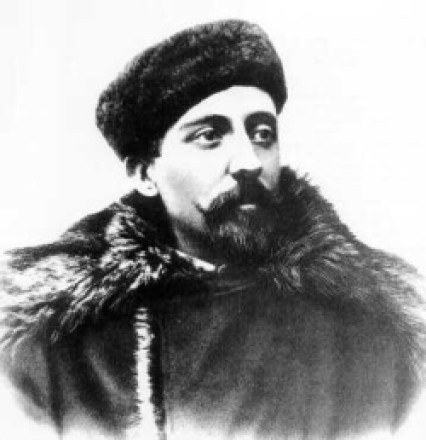History
Whaler repurposed as research vessel
The RV Belgica was built in 1884 in Norway as a whaler with the name Patria. The ship was powered by steam but also had a barque rig with three masts. Since the ship was a whaler, it had a reinforced construction with thick hull planking clad in iron, to protect her against the ice. In 1896, the Patria was purchased by the former Belgian navy officer Adrien de Gerlache, who renamed her RV Belgica and converted the ship to be used for an expedition to Antarctica.
Antarctic expedition
De Gerlache started his nautical career in the Belgian navy. After this, he worked on various vessels around the world before returning to the navy. He was employed as a officer on the Ostend-Dover ferry. During this period, he trained to become a captain. His heart was into adventure however. He had proposed various ideas to participate in expeditions to the Congo and the Arctic, but he had no success in getting these started. He then decided to mount his own expedition to Antarctica, proposing the idea to the Belgian Royal Geographic society in 1894.
He got their support and purchased the Patria, which was extensively refitted under his guidance and renamed RV Belgica. They set sail from Antwerp on August 16th, 1897, with an international crew of 23 people, including Roald Amundsen, Frederick Cook, Antoni Bolesław Dobrowolski, Henryk Arctowski and Emil Racoviță. They had loaded 40 tons of food.
The expedition charted formerly unexplored parts of Antarctica. The Belgica reached the coast of Graham Land on the Antarctic Peninsula in January 1898. The strait between this peninsula and a string of islands to the west, was named the Belgica Strait by de Gerlache. This strait was later renamed Gerlache Strait in his honour. They charted and named several islands end crossed the Antarctic Circle on 15 February 1898.

Later, the ship became trapped in the ice of the Bellinghausen Sea, near Peter I Island, on February 28th, 1898. They tried to get out, but quickly realised that they would be forced to spend the winter in Antarctica. Total darkness set in on May 17th, lasting until July 23rd. After this, it took seven months of waiting and hard labour to free the ship from the ice. Several men lost their sanity, including one Belgian sailor who left the ship, announcing he was going back to Belgium. Scurvy also started to plague the crew.
On February 15th, 1899, the Belgica was finally able to begin moving through the channel that the crew had cleared. It took them nearly a month to cover the seven miles to open water. On March 14th they cleared the ice.
The expedition returned to Antwerp on 5 November 1899. In 1901, de Gerlache publisehd a book on the expedition, called Quinze Mois dans l'Antarctique ('Fifteen Months in Antarctica'), which was awarded a prize by the Académie française in 1902. The ship was the first ship ever to overwinter in Antarctica. Later in his life, de Gerlache participated in a few other expeditions. The scientific reports from the expedition can be viewed online, as well as a photo album given to Amundsen (see references).
Later life of the ship
After the Belgian expedition, the Belgica was bought by Philippe, Duke of Orléans, who used it for two expeditions to the Arctic in 1905 and from 1907 to 1909. He sold it again in 1916, and the ship was refitted as a passenger and cargo ship that served between Spitsbergen and the Norwegian mainland, under the name Isfjord.
In 1918, the ship was sold again and named Belgica again. The sailing rigging was stripped and she was used as a factory ship. Later in the 1930's, she was used as a coal hulk in Norway. In April 1940, the ship was requisitioned by the Franco-British Expeditionary Force who used it to store explosives. When this force evacuated from Harstad during the German invasion, several British ships were scuttled on June 7th and 8th, 1940, to avoid them falling into German hands. This fate also befell the Belgica, which was anchored in the Brurvika cove at the time.
Description
Subtype: barque rigged steamship, originally used as a whaler
Yard: Christian Brinch Jørgensen, Selvik (Norway)

| Master | Gerlache, Adrien de |
|---|---|
| People on board | 23 |
| Length | 118 feet (36 m) |
| Draft | 13 ½ feet (4.1 m) |
| Beam | 25 feet (7.6 m) |
| Tonnage | 263 ton |
Status
Discovery and replica
The wreck of Belgica was discovered during Easter of 1990. In an article written by Norwegian maritime historian Kjell-Gudmund Kjær, the identity of the ship was confirmed. The anchor of the ship was recovered and is exhibited in the Polar Museum in Tromsø. Other artefacts were also recovered over the years.

The article inspired a group of Belgian historians to form a foundation aimed at raising the wreckage to be displayed in Belgium, called the Belgica Genootschap. Belgian divers have inspected the shipwreck and testing has been carried out to determine whether the vessel would survive a salvage attempt. An initiative to build a replica has also been launched, which has not been carried out yet.
References
- Genootschap Belgica.
Genootschap Belgica. - News in English.no.
Polar ship emerges from the depths. - Belgica Genootschap.
Wetenschappelijke rapporten. - Roald Amundsen’s House.
Belgica expedition album.